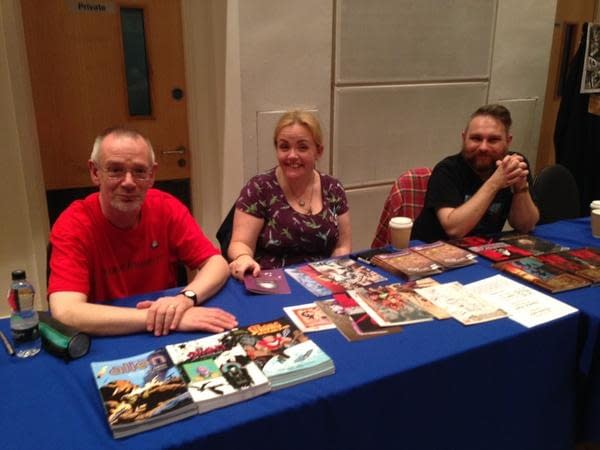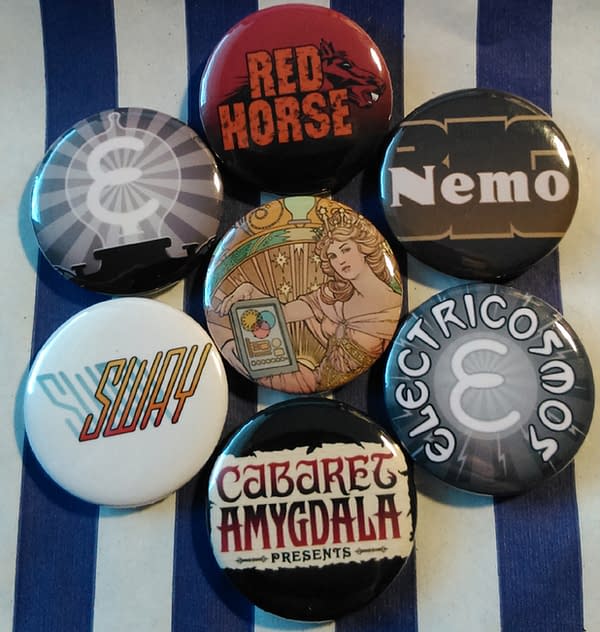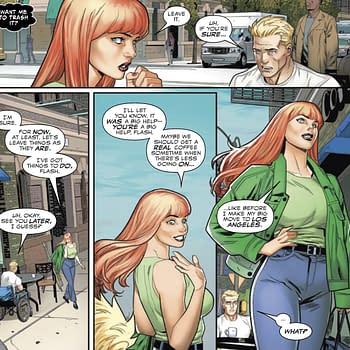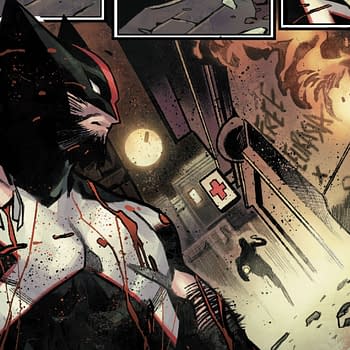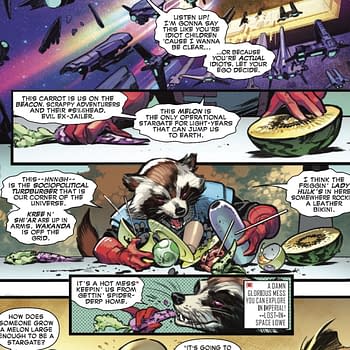Posted in: Comics | Tagged: Alan Moore, Daniel Merlin Goodbrey, digital comics, electricomics, entertainment, john reppion, leah moore, mitch jenkins, show pieces, thought bubble
Open Access 'Electricosmos' Is In Development – Electricomics Panel Highlights From Thought Bubble
I was particularly interested in attending the Electricomics panel at Thought Bubble this year, and extremely grateful that members of the Electricomics team even made time in their busy schedule to do some interviews with me (forthcoming on Bleeding Cool). When I arrived at the panel, our own Pop Culture Hound Chris Thompson was there, and was able to record the audio of the panel for an upcoming show (stay tuned), but I thought I'd bring you a few highlights of the discussion on Saturday, November 15th in Leeds at the Festival. An added bonus to the whole experience for me was having the pleasure of hosting the panel also.
For those of you who are new to Electricomics, this is an exciting research-based experimental project in digital comics that has received a grant from NESTA in the UK, not only to pilot new modes of reading interactive comics by app, but to share their findings and tools in an open-access forum from which other arts platforms and comic creators can benefit. The Electricomics team is fairly massive, including comic creators, media folks, digital researchers, and more, and for Thought Bubble, Leah Moore (the project's editor), John Reppion, and Peter Hogan (all comic creators for the pilot comics on the platform), Mitch Jenkins (photographer, filmmaker and co-founder of producing company Orphans of the Storm), and Daniel Merlin Goodbrey (an academic and expert in experimental digital comics) were in attendance at the Electricomics booth and at the panel.
An interesting origin point to keep in mind when considering the way cross-media interactions are affecting comics is that the Electricomics project actually spins out of an idea that Alan Moore had in making his film series with Mitch Jenkins, Show Pieces, and the same idea is a feature that may yet find its way into a TV or film version of this universe as it progresses toward a longer form that will be called The Show. In the context of the film-world, Moore imagined children reading comics on a flexible transparent screen known as a "spindle", and started the ball rolling with Jenkins to investigate a new interactive form of digital comics.
The panel opened with a video introduction by Alan Moore wherein he spoke about his initial concept that prompted the formation of the Electricomics project, a scenario in which he imagined that "all forms of electronic communication somehow connected up in some mysterious fashion, in which people could talk to each other all around the world and enjoy new sorts of entertainment media", and he also said that this project now contains some of the "very best writing talent and artistic talent in the industry, all coming together to tell stories in a new, hopefully improved way".
Early on in the panel, Leah Moore commented with some humor on the fact that Alan Moore is not someone you would exactly associate with cutting edge technology, given that he probably still has a pile of "manky old fax machines somewhere", however his involvement actually makes a statement central to Electricomics: this platform is being developed specifically as something accessible for comic creators who may not be tech savvy and may have no previous experience working in the digital format as well as those who are experienced already. The tools that they hope to develop will be eminently learnable without sophisticated training, therefore opening the doors on technological development for comic creators and would-be comic creators.
Goodbrey took great care to walk the audience through the development and research aspects of the Electricomics project, explaining that research papers will be produced along the way as tools are developed for the app so that the experiment process can benefit others as part of their grant requirements, making this a significant project from an academic perspective as well. That is a feature that sets the project apart from many other digital platforms that have been developed or are currently under development, in that the discoveries the team makes will not be proprietorial in this initial phase. "There will be quite a large knowledge-base that comes out of it", he said, "as a design case-study".
Mitch Jenkins later continued to lay out the schema of things by saying that the end goal is to produce a platform called "Electricosmos" which will be the open-access platform for using tools to create interactive digital comics, in which creators will be presented with quite a few choices about what interactive elements they'd like to include, and then there will also be Electricomics proper, the app which will contain the comics created by this pilot team of writers and artists, initially, with hopefully more to come after the first wave of "example" like releases. The initial comics are all quite diverse in genre and approach, purposefully using different interactive features to act as show pieces of their own to form an exemplar of what's possible as comic creators approach the app platform and new tools.
Both Leah Moore and Goodbrey spoke about the need to observe the digital projects that have preceded this one in comics, and Goodbrey is the go-to knowledge resource for the history of digital comics on the team, given his many years as a digital comics-creating pioneer in his own right. Seeking out these past approaches is a matter of choosing what has gone well and what hasn't in previous projects and building on them to create new things rather than simply recycling old ideas, it seems. Leah Moore, of course, has had recent experience working with comics that "move around" in producing The Thrill Electric for TV, and though she feels they "did interesting stuff with how you can progress through a page" on that project, but she doesn't feel they used a full range of technology to change how one tells a story in the way the team hopes to do through Electricomics.
Peter Hogan's comic for Electricomics, Cafe Amygdala, which involves heavy reader interaction for choosing the narrative's direction, will not even be presented in a "sequence", Leah Moore said. When she looked at the initial script for the 8 page comic, she found the panels didn't have numbers on them, because you "can read them in different orders" and there are "different points at which you can move to different parts of it". Her own story for Electricomics with John Reppion, Sway, involves "time travel" she said, and they are experimenting with reading the comic on an iPad using a "tilting" feature where motion for the iPad will help control moving backward and forward in time.
As John Reppion then commented during the panel, when it comes to digital comics, readers often feel that they are not as much "in control" of the reading experience as they would be when holding a print comic in terms of page turn, speed of reading, and the like, especially when interactive features might seem to be pushing you through a reading experience more quickly. Electricomics is set to change that as each aspect of interaction is fully controlled by the reader.
Leah Moore provoked plenty of humor and speculative wonder, I'd say, in the panel by adding that out of the set number of tools they are currently developing (and they will be very specifically focused during this early phase), each of the comic creators have selected certain tools to use, however, Alan Moore looked at the tools, "went off" and has used them "all" in his Nemo comic to debut on the Electricomics platform. He has happily incorporated them all into the new work, making life a little challenging for the artist on the comic, Colleen Doran.
You'll be able to hear the full panel audio recording and more coming soon as a special edition of Pop Culture Hounding Electricomics, and stay tuned for a whole series of interviews coming out of Thought Bubble with the Electricomics team.
Hannah Means-Shannon is EIC at Bleeding Cool and @hannahmenzies on Twitter




